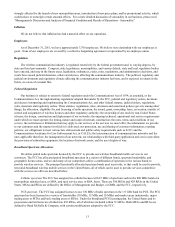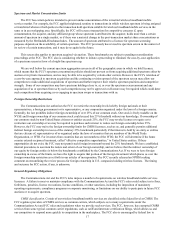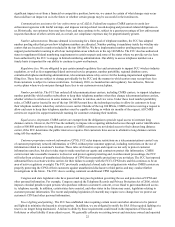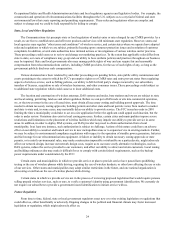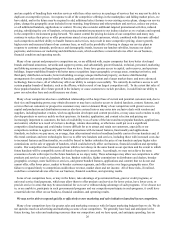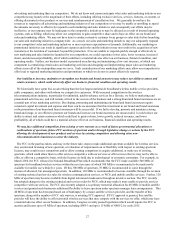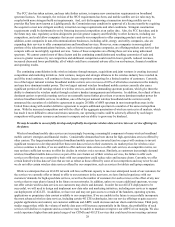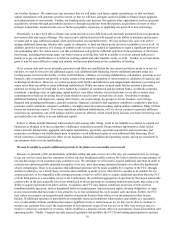Metro PCS 2011 Annual Report Download - page 32
Download and view the complete annual report
Please find page 32 of the 2011 Metro PCS annual report below. You can navigate through the pages in the report by either clicking on the pages listed below, or by using the keyword search tool below to find specific information within the annual report.21
In October 2010, the President signed into law the Twenty-First Century Communications and Video Accessibility Act of
2010, or the Accessibility Act. The Accessibility Act is intended to ensure that individuals with disabilities have access to
emerging Internet-protocol-based communication and video programming technologies in the 21st Century, by updating
requirements of television, telephone, and Internet service providers. These new obligations govern the provision of advanced
communications services, including interconnected and non-interconnected VoIP services, to persons with disabilities, record-
keeping related to adherence to these policies, and the provision of Internet browsers suitable for blind or visually-impaired
individuals. The Accessibility Act requires the FCC to implement its provisions, and the FCC has issued a series of public
notices and order seeking comment on, and implementing aspects of the Accessibility Act.
E-911 service. The FCC requires CMRS providers to implement basic 911 and enhanced, or E-911, emergency services
for our voice services. Our obligation to implement these services is incurred in stages on a market-by-market basis as local
emergency service providers become equipped to handle E-911 calls. E-911 services allow state and local emergency service
providers to better identify and locate wireless callers, including callers using special devices for the hearing impaired. The
FCC revised these rules in October 2010. The network equipment and handsets we utilize are capable of meeting the FCC's
E-911 requirements and we have constructed facilities to implement these capabilities in areas where we have had requests to
do so from local public safety emergency service providers. Because we employ a handset-based location technology, we also
are subject to the FCC rules that require us to ensure that specified percentages of the handsets in service on our systems are
location-capable and meet certain location accuracy standards. The FCC also issued an NPRM seeking comment on the current
state of wireless location technologies, and has posed questions about possible future modifications and enhancements to the
current rules. In an accompanying NOI, the FCC seeks comment on issues associated with VoIP services, including whether
911/E911 obligations should be extended to non-interconnected VoIP services and short message services. The FCC actively
monitors the compliance by CMRS carriers with E-911 requirements. The FCC has in the past, and may in the future, impose
substantial fines, forfeitures and penalties on wireless broadband mobile carriers for their failure to comply with the FCC's
E-911 rules and could impose other sanctions, including revocation of licenses or the imposition of mandatory reporting
requirements, license conditions, corporate monitors, and compliance programs. The FCC also has rules under which wireless
broadband mobile carriers may be required to offer priority E-911 services to the public safety agencies under certain
circumstances. While we may in certain instances be able to recover the expenses associated with E-911, certain states in which
we do business may limit or eliminate our ability to recover our E-911 costs.
Spectrum clearing. Spectrum allocated for AWS has been utilized by a variety of categories of commercial and
governmental users. The spectrum allocated for AWS-1 was utilized by certain governmental users, many of whom are required
over time to relocate from the AWS-1 spectrum. However, in some cases, not all incumbent users have relocated or are
obligated to relocate and, in other cases, may not be obligated to relocate for some period of time, with varying time frames for
relocation. To foster the orderly clearing of the spectrum, the FCC adopted a transition and cost sharing plan pursuant to which
incumbent non-governmental users are reimbursed for relocating to other spectrum and with the costs of relocation being
shared by AWS-1 licensees benefiting from the relocation. Under the FCC relocation plan, the AWS-1 licensee and the
incumbent non-governmental user negotiate voluntarily for three years and then, if no agreement has been reached, the
incumbent licensee is subject to mandatory relocation procedures in which the AWS-1 licensee can relocate the incumbent non-
governmental licensee at the AWS-1 licensee's expense. Since our AWS licenses were granted in 2006, the time period for
voluntary relocation has lapsed.
Siting issues. The location and characteristics of wireless antennas, DAS systems and nodes, base stations and towers are
subject to FCC and Federal Aviation Administration, or FAA, regulations, federal environmental regulations, and other federal,
state, and local regulations, including local zoning, building, and electrical requirements. The FCC has adopted rules that are
intended to expedite siting decisions by state and local authorities, but the rules have been the subject of legal challenges. With
respect to AWS-1 sites, we must notify the FAA when we add AWS-1 frequencies to existing sites that already have been
determined not to be a hazard to air navigation by the FAA. Antenna structures used by us and other wireless providers also are
subject to FCC rules implementing the National Environmental Policy Act and the National Historic Preservation Act. Under
these rules, construction cannot begin on any structure that may significantly affect the human environment, or that may affect
historic properties, until the wireless provider has filed an environmental assessment with and obtained approval from the FCC
or a local agency. Processing of environmental assessments can delay construction of tower and antenna facilities, particularly
if the FCC or local agency determines that additional information is required or if community opposition arises. In addition,
several environmental groups have requested various changes to the FCC's environmental processing rules, challenged specific
environmental assessments as failing statutory requirements and sought to have the FCC conduct a comprehensive assessment
of the environmental effects of antenna tower construction. The FCC also has been ordered by the Court of Appeals for the DC
Circuit to further consider the impact that communications facilities, including wireless towers and antennas, may have on
migratory birds, and the FCC recently issued an order adopting procedures to mitigate such concerns. In the meantime, there
are a variety of federal and state court actions in which citizen and environmental groups have sought to deny individual tower
approvals based upon potential adverse impacts to migratory birds. Compliance with these rules and regulations has not had a




